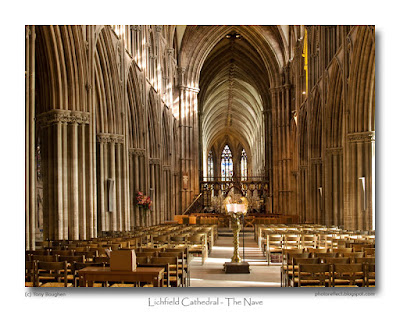 click photo to enlarge
click photo to enlargeI've been doing some decorating of the house recently, although to be more accurate I should say that I've been helping my wife to do it, she being the one who takes the lead in such things. It's only when you do something like this that you realise how fond builders are of approximation. Hang wallpaper and you notice that walls are sometimes very slightly off vertical. Laying floor tiles can lead to the discovery that what you thought was a rectangular room is actually a touch rhomboidal. Tiny imprecisions of this sort don't matter a geat deal in a house, where the rooms are relatively small, vistas are limited, and ones eyes don't often line up one surface or edge against another.
However, in a big building, such as a medieval church, and particularly a cathedral, if you don't get the floor plan right, if lines are not laid correctly, if right angles are a degree or two wrong, then once the building is completed these imperfections are magnified. And, at that point it's a couple of hundred years later, and taking it all down and rebuilding it straight isn't really an option. Such is the case at Lichfield Cathedral in Staffordshire. The earliest building on the site dated from about 700A.D. Nothing of that remains, and little of its Norman succesor of the C12 is to be seen either. However, the Gothic structure that was built from the 1200s onwards is still very much in evidence, though repaired down the centuries after damage from neglect, falling towers, and the fighting of the Civil War. It was the Gothic masons, it seems, who got the nave and chancel out of line (though they may have been building on the foundations of the Normans). Stand in the nave, as I did for the photograph above, and the leftward lurch of the chancel is evident. So too are the leaning nave piers. Further collapse was averted by the architect, James Wyatt, in the late eighteenth century, by the expedient of replacing the 500 tons of stone nave vaulting with lighter lath and plasterwork in the style of vaulting.
Imperfections aside, I think you'll agree that the view inside Lichfield, with its forest of verticals (and almost verticals) reaching their climax in the pointed arches and vaulting ribs, is magnificent.
photograph & text (c) T.Boughen
Camera: Olympus E500
Mode: Aperture Priority
Focal Length: 27mm (54mm/35mm equiv.)
F No: f5.6
Shutter Speed: 1/5
ISO: 200
Exposure Compensation: 0 EV
Image Stabilisation: N/A